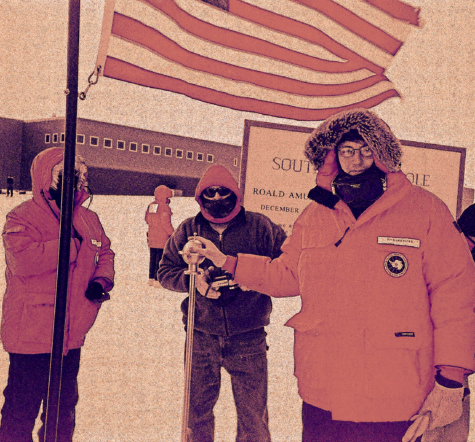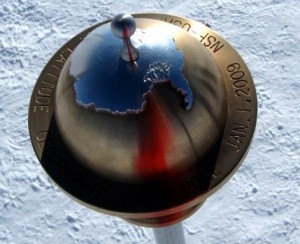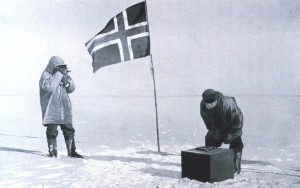This post first ran on Dec. 31, 2010, though with a different main image, and it has run just about every New Year’s Eve since then. Back in the day, the lead image was a close-up of the crown of the 2009 pole. That image still appears as part of this essay, only farther down. Instead, the new image at the top of this post is a photo of me at the Pole resting my hand on the crown of the pole. I made the substitution after this photo resurfaced on a long-forgotten roll of film. Yes: “roll of film.” Hence, above, the funky contrast, the inconsistent tint, the overall granularity, etc. (Also, as has become customary, I’ve changed the dates in this year’s post to keep it current.)
By the time you’re reading this post, 2024 will have already arrived at the South Pole. Even if you’re reading it the instant it pops up on the Internet, at 7 a.m. EST December 31, 2023, the New Year will already be an hour old. Unless, of course, you happen to be obsessively refreshing your LWON bookmark from the Line Islands (pop. ~ 8,000), the easternmost atolls in the Republic of Kiribati, or from the Chatham Islands (pop. 730), a New Zealand archipelago not only way off the southeastern coast of the mainland but in a time zone all its own (and how cool is that?).
You don’t have to go to the South Pole to appreciate how arbitrary our conceptions of space and time are, but it helps. And fifteen years ago today (tomorrow? yesterday?) I found myself, thanks to a grant from the National Science Foundation to support research for a book, at the Pole.
By “at the Pole,” I don’t mean just at the Amundsen-Scott South Pole Station, the modern and rather posh living quarters for the approximately 200 scientists and support personnel who work there during the October-to-February austral summer, as well as the 50 or so who keep the place running for the rest of the year.
Nor do I mean the various outposts within walking distance where scientists conduct research in astronomy, geology, particle physics, climatology, and other areas.
And I don’t mean the ceremonial South Pole, the striped-barbershop photo-op version, semi-encircled by the flags of the twelve nations that signed the 1961 treaty setting aside the continent for scientific pursuits.
I mean at the Pole.
The Amundsen-Scott station perches 9,300 feet above sea level, of which the first 9,000 feet down are ice. That ice sheet drifts about 10 meters each year, taking with it the station, the research outposts, and a pole—a metal shaft that sticks out of the ice. Unlike the ceremonial pole several dozen yards away, this pole designates the geographic South Pole—one end of the axis around which the Earth rotates. Every New Year’s Day the pole is relocated from the point where the Pole was a year earlier to the point where the GPS says the Pole is now.
The New Year’s Day I was there, however, the tradition came with a new addition. “Line up,” someone from the National Science Foundation told the score or more of us who had ventured from the station to witness the ceremony. We lined up, starting at the pole. Someone lifted the pole and passed it to the next person in line. That person passed it to the next, and then that person passed it to the next, and so on. As the pole made its way down the line to my right, I turned to my left, to see to whom I would soon be passing the pole. Nobody was there. I was at the end of the line. Instead of the boots of one more Polie, I found myself looking at a hole in the snow. This hole, I realized with a start, was the Pole.
Dare I step on it? Then I would really, truly be at the South Pole. But stepping on a hole that someone had pre-drilled seemed sacrilegious, or at least risky; what if snow spilled into the hole and I ruined the whole ceremony? Then again, not stepping on it seemed like missing the chance of a lifetime. In a moment, a pole was going to be in that hole, and nobody would be able to stand at the Pole—really, truly—for another year. Or stand at the Pole knowingly, anyway, since the ice sheet would be drifting, and you might well be standing next to the pole yet standing on the Pole. But right now, at this precise moment, the Pole was naked. And accurate.
A glance to my right. The pole was maybe a dozen people away. They were passing, passing, passing.
A glance to my left. The hole was half a foot away. My boot was threatening to take on a life of its own. My toes were clenching and unclenching, straining against the hard and blunt boot tip. My arch was arching, then relaxing. In the end, though, the boot didn’t budge.
Instead, I did. I leaned over. Looked down. Peered into the hole, or down the two or three inches that were visible. If I could see farther, if I could keep seeing down, if my vision could drill through the Earth, then I would eventually reach the North Pole, the other end of the axis around which the planet rotates. I thought about how cosmologists often answer the question of what came before the Big Bang: It’s like asking what’s north of the North Pole. Or, similarly, what’s south of the South Pole.
From here, from this precise point, the world went nowhere but north, like a universe expanding. What did it expand into?—another common question about the Big Bang. The answer: The universe didn’t expand into anything. It became space. It became time. The more space that it became, the more time that passed.
I straightened and turned back. The pole had arrived. I accepted it from the Polie to my right, and then an NSF official stepped up to me and held out his gloves. I handed him the pole. At several minutes past 1 p.m., he planted it.
But wait. How does this space where there’s nowhere but north—where time zones originate before fattening with the longitudes all the way to the Equator, then thinning again until they converge at the point where there’s nowhere but south—get this time? Why is the moment of the planting of the pole at 1 p.m. January 1 rather than, say, 7 p.m. December 31? Why is the South Pole Station, along with a healthy swath of Antarctica, on New Zealand Time, which is the first time zone west of the International Date Line?
Because the treaty said so.
By the way, the International Telecommunications Union added a leap second at midnight that year. But let’s not go there.
* * *
Image credits: Unknown (top); Nick Powell, courtesy of the National Science Foundation (middle); “Taking an observation at the pole,” The South Pole, by Roald Amundsen, Volume II (bottom).



Hi Richard,
I’m impressed knowing someone who has been to either Pole, where I’ve never been. But I’ve asked similar questions, such as what’s north of north or what’s south of south. While those fixes have some bearing, they really don’t have any on me. The questions always bring me back to my original one about time, such as, is there really time, or is it all man made as a construct to explain what’s going on in the universe? As a poet I try to deal with meter, and the questions are similar to yours. Is an iambic pentameter line some kind of Procrustean construct into which one fits a line of poetry, like trying to get back into an old suit that one has outgrown? We know that’s not so, for the iambic pentameter line is natural to English speech, and again, the real question is about which came first. Since so much of our language came from oral tradition, we’ll never really know, except in the poems that have been passed down to us in folklore.
Much of what I’ve said is far removed from the North Pole or the South Pole, but I think the questions are related.
Thank you for sharing this topic.
George Chappell
Thanks, George. Invigorating thoughts!
Happy New Year,
Richard
Richard,
I know you are a man of science, but for me, this piece has a very spiritual quality to it. I love the vision of the ritual of passing the pole. I am thrilled that you were the last one it was passed to, and that you were able to set your head over the south pole. I don’t really understand time or space or north or south, but this essay made me feel a little closer to knowing…something. Happy New Year!
Maria
Thanks very much! Feeling a little closer to knowing something is maybe the best we can do. But I am hardly a man of science. I have no background in science. I just try to–as you say–get a little closer to knowing something, and to treat the reader to the same thrill. I very much appreciate the comment, and Happy New Year to you, too.
Richard, It’s admirable that you didn’t want to step on the S. Pole hole, but you could have straddled it! This is what Phyllis and I did at the Greenwich Prime Meridian. (See our photo in the photographs section of my website.)Meanwhile, I didn’t understand what you meant that in terms of the planet proper, the S.P. was 9000ft.straight down.
P.S. My admirable act was returning to Yellowstone a piece of geyserite I’d stolen years before. (Photo on website.)
Thanks, Herman. By “planet proper,” I meant the non-ice coated surface of the earth. Hope that clarifies!
It does, Richard. There was 9,000 ft. of ice between you and terra firma!
To astronomers, the Greenwich meridian is boring. It is an arbitrary invention so that we can fix longitude. Fresno would work just as well. The Fresno meridian! cool. Same with celebrating New Year’s Eve. Don’t invite a bunch of astronomers to your party because some will tell you that the beginning of a year is totally arbitrary and why celebrate a random date chosen a long time ago? April 23 at 11:02 am would work as well for the beginning of the year. Astronomers can suck the life out of a New Years Party. I know I have.
The pole, however, is real. The Earth rotates on that axis. It is not a convention. We base our clocks on it (but maybe not in the future). The stars move in the sky because of the rotation. It is easy to fix your latitude with even a stick because of the rotation. The Coriolis force which governs large scale patterns relies on it. The ocean currents…
You get my drift.
But the question of what is south of south or north of north is both arbitrary but fundamental. You follow your compass to the south pole and when you straddle that hole, there is no south. Everything is north. South suddenly becomes north. But that does not mean at the pole directions do not exist. You could get out your AAA map of the pole and you would find you could easily navigate across it. You just can’t used latitude and longitude coordinates precisely at the pole. That is, the pole should remind us that sometimes it is our perspective that is the problem, or that we have chosen a particular reality to describe something that cannot be described that way.
Well, suppose instead of a magnetic compass, I have time compass with a little arrow that always points backward in time. Actually I do have one. It is called a telescope because the farther I see into the Universe, the farther back in time I go. But let us think of it as a compass. I follow the compass arrow back in time, and get closer and closer to the Big Bang. And then, in my mind, I follow the arrow backward in time and step right on top of the Big Bang.
Wow! Creation! The beginning of the Universe! We invent gods to create this moment! Wars are fought over whose god is the most badass! Nobel Prizes will be won!
but wait. Think of the south pole. I can easily walk over the south pole, even though at the precise pole there is no longer any south. When I step over the pole, S goes from S suddenly into N. It is merely because I have chosen the wrong coordinates to describe the geography around the pole that this crazy thing happens. My AAA map tells me that the pole is nothing special. There is still a real point there. I just need to describe the geography differently.
And the same goes for time. Who is to say that time is the right coordinate to describe the early Universe? Maybe if I had a AAA physics map with different coordinates, I could step across t=0 into ?
That is, is the beginning of the Universe arbitrary because we have chosen a coordinate system that works well here in our older universe, but becomes singular at t=0? What happens if I step across t=0 into? Time will suddenly be going forward again, but to where? Physics and cosmology do not really tell us. But maybe it is our perspective of the single arrow of time that is wrong.
I developed a habit that started with my now almost 22-year old nephew, and has since continued with my youngest daughter and now my grandsons. The habit is, when encountering any hole whilst out and about, to place an ear at the opening and wonder aloud “does it sound like the ocean?” This has been a favored activity whether we are on the beach and encounter a shell, or in a forest and encounter a hole in a tree, or a hole in the road or a sidewalk. The first thing that came to my mind when reading your post was a chance to put my ear to the Pole hole and wondering “does it sound like the ocean?”
Wish I’d thought to do that!
Happy new year! Thank you for an excellent story! I was waiting for a scientific reveal I wouldn’t understand, but it was a diplomatic reveal that is quite understandable, but one that feels rare and precious in our current time.